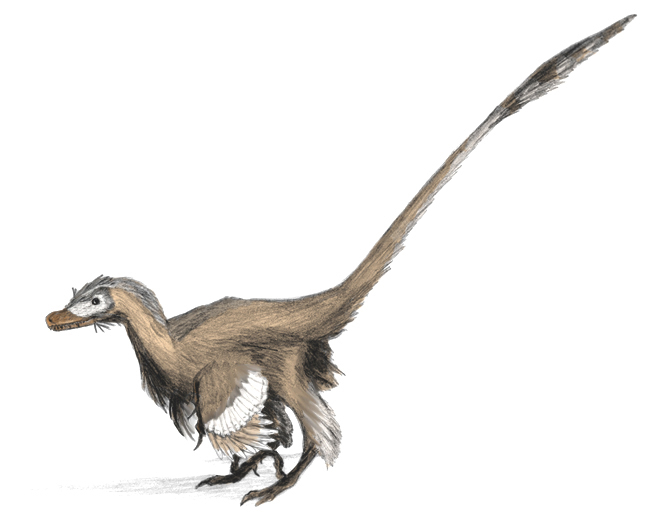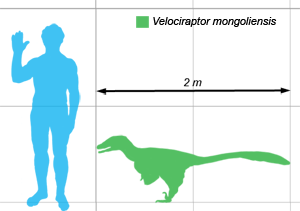home > natural history
Velociraptor mongoliensis
"Mongolian swift thief"

If Deinonychus was a protoavian wolf, then it's Asian cousin, the 6ft long Velociraptor was a feathered fox. Known from the Gobi Desert of Mongolia, Velociraptor lived along side (and probably hunted) other flightless birds like Mononykus, Shuvuuia, and the various species of oviraptorid that nested in its environment, as well as the small horned dinosaur Protoceratops (evidence for this comes from the famous "fighting dinosaurs" specimen of a Velociraptor and a Protoceratops locked in combat). Like smaller ornithodesmids, Velociraptor had long wing feathers, as evidenced by quill knobs on the arm bones that served as feather anchor points. Not all birds have quill knobs and they are usually only present in strong fliers and their decendands, adding evidence to the hypothesis that deinonychosaurs like Velociraptor were secondarily flightless birds. In its smaller relatives, these feathers are thought to have aided in gliding through trees. Being a desert animal, Velociraptor may have used its wings to engage in a behavior known as 'wing-assisted incline running' up sand dunes, gliding from dune to dune in pursuit of prey, and/or mating display or shielding nests while brooding. Ornithodesmids were slow for theropods and probably ambush predators, but in an environment like the Gobi Desert there isn't much cover for surprise attacks, and any techniques, like gliding, would be a useful advantage for an otherwise slow moving predator. This type of behavior was probably infeasible for larger, heavier adults but may have come in handy for juveniles.
Unlike the relatively huge, reptillian "raptors" depicted in Jurassic Park, Velociraptor were small (2 m or 6 ft long, about 2.5 to 3ft tall) flightless birds, likely descended from flying or gliding, Archaeopteryx-like ancestors. Many of these primitive birds, like Microraptor, Pedopenna, and Archeopteryx istelf, had long feathers on the legs, adapted into full-fledged hind wings in some species. I've reconstructed the leg feathers of Velociraptor conservatively, similar to those found in Archaeopteryx, since it was a primarily ground-dwelling bird and long feahters may have gotten in the way of running.
For more on Velociraptor, see the Wikipedia article I helped edit.
Image License:
Creative Commons Attribution 2.5
You are free to Share (transmit, copy, and distribute) and to Remix (adapt or modify) the images on this page Under the following conditions: You must Attribute the work by giving written credit to Matt Martyniuk and linking to this Web site: http://www.azhdarcho.com (but not in any way that suggests that they endorse you or your use of the work).
For any reuse or distribution, you must make clear to others the license terms of this work. The best way to do this is with a link to this web page.Any of the above conditions can be waived if you get permission from the copyright holder. Nothing in this license impairs or restricts the author's moral rights.
DESCRIPTION
Length: 2.07m (6.8ft)
Weight: 15kg (33lbs)
Location: Djadochta Formation, Ömnögovi, Mongolia and Inner Mongolia, China
Time: Campanian age, Upper Cretaceous (~80 Ma)
CLASSIFICATION
Kingdom: Animalia
Phylum: Chordata
Class: Stem-Aves
Family: Ornithodesmidae
Genus: Velociraptor
Species: V. mongoliensis
SYSTEMATICS
Sauropsida
Diapsida
Archosauria
Ornithosuchia
Dinosauria
Theropoda
Coelurosauria
Maniraptora
Dromaeosauridae
